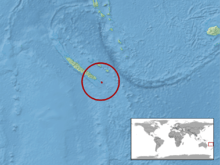Terror skink
| Terror skink | |
|---|---|
| Scientific classification | |
| Kingdom: | Animalia |
| Phylum: | Chordata |
| Subphylum: | Vertebrata |
| Class: | Reptilia |
| Order: | Squamata |
| Suborder: | Sauria |
| Infraorder: | Scincomorpha |
| Family: | Scincidae |
| Subfamily: | Eugongylinae |
| Genus: | Phoboscincus |
| Species: | P. bocourti |
| Binomial name | |
| Phoboscincus bocourti (Brocchi, 1876) | |
 | |
| Synonyms | |
The terror skink (Phoboscincus bocourti), also called Bocourt’s terrific skink or Bocourt's eyelid skink, is a species of skink endemic to the Île des Pins (Isle of Pines), a small islet off the coast of New Caledonia. First described in 1876, it was presumed to be extinct, but was rediscovered in 1993, and since then several individuals have been seen. Because of its small area of occupation and small population size, the International Union for Conservation of Nature has assessed its conservation status as being "endangered".
Etymology
The specific name, bocourti, is in honor of French zoologist Marie Firmin Bocourt.[3]
Distribution
Phoboscincus bocourti is endemic to the Île des Pins (Isle of Pines), an islet with an area of 0.5 square kilometres (0.19 sq mi) off the coast of New Caledonia.[2] It may be present on other islands in the locality.[1]
This rare species was considered extinct until being rediscovered in 1993, and in December 2003, a specimen was found by some specialists from the French Muséum national d'histoire naturelle (the animal was photographed and filmed before being released). Before, it was only known from a single specimen, collected on the same island by a man named Balanza. Further individuals have been discovered in 2009 and 2013.[2]
Diet
The teeth of P. bocourti are long, curved and sharp, suggesting predatory habits unusual for a large skink; most skinks are omnivorous. Its diet might include larger invertebrates, other lizards, young birds, and eggs.
Description
It is about 50 centimetres (20 in) long, making it the third largest reptilian predator on the island, the others being a prehistorically extinct land-going crocodile and goanna.
Behavior
It is presumed to be diurnal and mainly terrestrial, but may be partially arboreal.[1]
Threats
With such a small area of occupation, this skink is subject to threats such as habitat loss through a typhoon or wildfire, and the possibility of predatory animals being introduced to the island. The International Union for Conservation of Nature has assessed its conservation status as being "endangered".[1]
References
- 1 2 3 4 Sadlier RA, Whitaker AH, Bauer AM (2009). "Phoboscincus bocourti". IUCN Red List of Threatened Species. Version 2011.1. International Union for Conservation of Nature. Retrieved 18 January 2016.
- 1 2 3 Phoboscincus bocourti at ReptileDatabase.cz
- ↑ Beolens B, Watkins M, Grayson M. (2011). The Eponym Dictionary of Reptiles. Baltimore: Johns Hopkins University Press. xiii + 296 pp. ISBN 978-1-4214-0135-5. (Phoboscincus bocourti, pp. 28-29).
Further reading
- Brocchi [P]. 1876. "Sur un Scincoïdien nouveau appartenant au genre Eumèces". Bulletin de la Société philomathique de Paris, Series 6, 12: 95-97. (Eumeces bocourti, new species).
- Greer AE. 1974. "The genetic relationships of the Scincid lizard genus Leiolopisma and its relatives". Australian Journal of Zoology Supplementary Series 22 (31): 1-67. (Phoboscincus, new genus).
External links
- Description page, including photographs
- "Molecular phylogeny of the scincid lizards of New Caledonia and adjacent areas"
- IUCNRedlist.org
- Caut S, Holden M, Jowers MJ, Boistel R, Ineich I. (2013). "Is Bocourt’s Terrific Skink Really So Terrific? Trophic Myth and Reality." PLoS ONE 8 (10): e78638. doi:10.1371/journal.pone.0078638.
